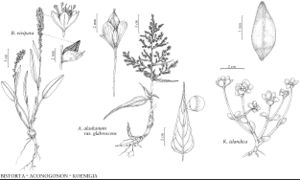Bistorta
Meth. Pl., 24. 1754.
| Taxon | Illustrator ⠉ | |
|---|---|---|
 | Bistorta vivipara Aconogonon alaskanum var. glabrescens Koenigia islandica | Yevonn Wilson-Ramsey Yevonn Wilson-Ramsey Yevonn Wilson-Ramsey |
Herbs, perennial; roots fibrous, rhizomatous. Stems erect, simple, glabrous. Leaves mostly basal, some cauline, alternate, petiolate or sessile; ocrea persistent or disintegrating with age and deciduous entirely or distally, chartaceous; blade linear or lanceolate to elliptic, oblong-ovate, or ovate, margins entire or obscurely and irregularly repand. Inflorescences terminal, spikelike. Pedicels present. Flowers bisexual, 1–2 per ocreate fascicle, base not stipelike; perianth nonaccrescent, white, greenish white, pink, or purplish-pink, rarely red, campanulate, glabrous; tepals 5, connate proximally ca. 1/5 their length, petaloid, monomorphic or slightly dimorphic, outer larger than inner; stamens 5–8, sometimes poorly developed; filaments distinct or connate basally, outer ones sometimes adnate to perianth-tube, glabrous; anthers yellow, pink, red, purple, or blackish, ovate to elliptic; styles 3, erect or spreading, distinct or connate proximally; stigmas 2–3, capitate. Achenes included or exserted, brown to dark-brown, unwinged, 3-gonous, glabrous. Seeds: embryo curved. x = 11, 12.
Distribution
Arctic and temperate North America, Europe, Asia
Discussion
Species ca. 50 (4 in the flora).
Bistorta often is included in Polygonum in the broad sense or in Persicaria. It is accepted here as a distinct genus based on habit, morphology, and anatomy (K. Haraldson 1978; L.-P. Ronse Decraene and J. R. Akeroyd 1988). In the species of the flora area, the base of the petiole forms a long, tubular sheath distal to the node from which the leaf arises and proximal to the point of divergence of the petiole. Distal to the sheath is the ocrea, which usually is darker and thinner.
Selected References
None.
Key
| 1 | Inflorescences narrowly elongate-cylindric, (15-)20-90 × 4-10 mm, usually bearing pyriform, pink to brown or purple bulblets proximally | Bistorta vivipara |
| 1 | Inflorescences short-cylindric to ovoid, 10-70 × 8-25 mm, bulblets absent | > 2 |
| 2 | Leaf blade bases abruptly contracted, truncate to cuneate; petioles prominently winged distally; perianths pink | Bistorta officinalis |
| 2 | Leaf blade bases usually tapered to rounded, rarely abruptly truncate or cuneate; petioles wingless or rarely winged distally; perianths white to pale pink, bright pink, or purplish pink | > 3 |
| 3 | Perianths bright pink or purplish pink; basal leaf blades with apices rounded to acute; plants (8-)10-40(-50) cm; n Canada, Alaska | Bistorta plumosa |
| 3 | Perianths white or pale pink; basal leaf blades with apices usually acute to acuminate, rarely obtuse; plants (10-)20-70(-75) cm; sw Canada, w United States | Bistorta bistortoides |
"/2" is not declared as a valid unit of measurement for this property.